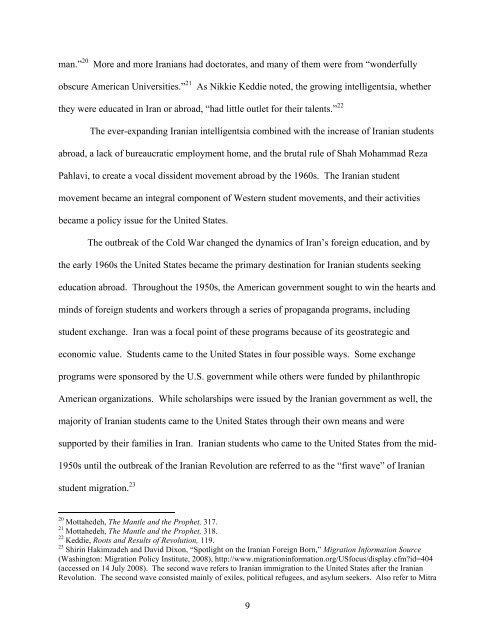AN AUGURY OF REVOLUTION: THE IRANIAN STUDENT ...
AN AUGURY OF REVOLUTION: THE IRANIAN STUDENT ...
AN AUGURY OF REVOLUTION: THE IRANIAN STUDENT ...
You also want an ePaper? Increase the reach of your titles
YUMPU automatically turns print PDFs into web optimized ePapers that Google loves.
man.” 20 More and more Iranians had doctorates, and many of them were from “wonderfully<br />
obscure American Universities.” 21<br />
As Nikkie Keddie noted, the growing intelligentsia, whether<br />
they were educated in Iran or abroad, “had little outlet for their talents.” 22<br />
The ever-expanding Iranian intelligentsia combined with the increase of Iranian students<br />
abroad, a lack of bureaucratic employment home, and the brutal rule of Shah Mohammad Reza<br />
Pahlavi, to create a vocal dissident movement abroad by the 1960s. The Iranian student<br />
movement became an integral component of Western student movements, and their activities<br />
became a policy issue for the United States.<br />
The outbreak of the Cold War changed the dynamics of Iran’s foreign education, and by<br />
the early 1960s the United States became the primary destination for Iranian students seeking<br />
education abroad. Throughout the 1950s, the American government sought to win the hearts and<br />
minds of foreign students and workers through a series of propaganda programs, including<br />
student exchange. Iran was a focal point of these programs because of its geostrategic and<br />
economic value. Students came to the United States in four possible ways. Some exchange<br />
programs were sponsored by the U.S. government while others were funded by philanthropic<br />
American organizations. While scholarships were issued by the Iranian government as well, the<br />
majority of Iranian students came to the United States through their own means and were<br />
supported by their families in Iran. Iranian students who came to the United States from the mid-<br />
1950s until the outbreak of the Iranian Revolution are referred to as the “first wave” of Iranian<br />
student migration. 23<br />
20 Mottahedeh, The Mantle and the Prophet, 317.<br />
21 Mottahedeh, The Mantle and the Prophet, 318.<br />
22 Keddie, Roots and Results of Revolution, 119.<br />
23 Shirin Hakimzadeh and David Dixon, “Spotlight on the Iranian Foreign Born,” Migration Information Source<br />
(Washington: Migration Policy Institute, 2008), http://www.migrationinformation.org/USfocus/display.cfmid=404<br />
(accessed on 14 July 2008). The second wave refers to Iranian immigration to the United States after the Iranian<br />
Revolution. The second wave consisted mainly of exiles, political refugees, and asylum seekers. Also refer to Mitra<br />
9















